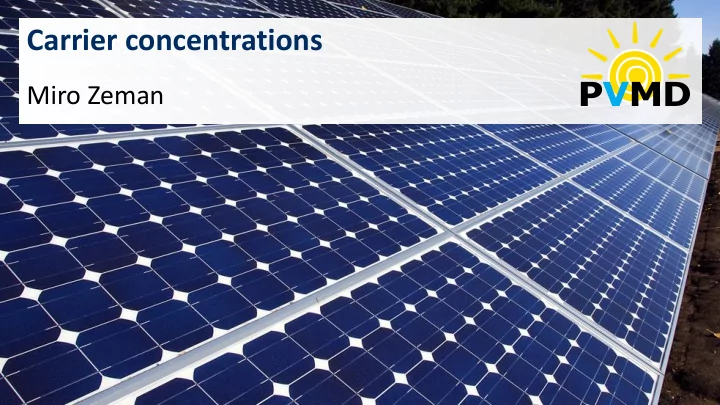

Carrier concentrations PVMD Miro Zeman Delft University of Technology
Equilibrium Equilibrium The unperturbed state of a system, to which no external voltage, magnetic field, illumination, mechanical stress, or other perturbing forces are applied. ▪ At thermal equilibrium the observable parameters of a semiconductor do not change with time
Density of 1 States
Density of energy states (DOS) Density of energy states function, g (E) Describes the number of allowed energy states for electrons per unit volume and energy. E E Conduction g C band E C E C Band gap E G E G energy E V E V g V Valence band g(E) Arno H.M. Smets et al., Solar energy, 1 st edition, page 53
Density of energy states function Conduction band Valence band E g C 3 3 * * 2 2 m 2 2 m p n g ( E ) 4 E E g ( ) E 4 E E E C C C 2 V V 2 h h E G E V g V g V DOS in valence band g C DOS in conduction band E Electron energy E Electron energy E V Highest energy level of VB E C Lowest energy level of CB m p Hole’s mass m n Electron’s mass g(E) h Planck’s constant h Planck’s constant Arno H.M. Smets et al., Solar energy, 1 st edition, page 52
Occupation 2 function
Occupation function, f (E) Fermi-Dirac distribution function, f (E) Gives the probability that a given available electron-energy state will be occupied at a given temperature.
Fermi-Dirac distribution function, f (E) ▪ Temperature dependence 1.0 1.0 1.0 T= 0 K T= 0 K T= 0 K T= 100 K T= 100 K 0.8 0.8 0.8 T= 200 K 0.6 0.6 0.6 f(E) f(E) f(E) 0.4 0.4 0.4 T= 300 K 0.2 0.2 0.2 T= 400 K 0.0 0.0 0.0 -0.3 -0.3 -0.2 -0.2 -0.1 -0.1 0.0 0.0 0.1 0.1 0.2 0.2 0.3 0.3 -0.3 -0.2 -0.1 0.0 0.1 0.2 0.3 E-E F (eV) E-E F (eV) E-E F (eV)
3 Fermi level
Fermi Level Fermi level, E F The total average energy of an electron related to its electro- chemical potential in a material. 1 ▪ Energy level for which f(E) = E C 2 ▪ E F in intrinsic semiconductor is approximately E F = E Fi in the middle of the band gap E V
Boltzmann Approximation When E C E F E V
Charge carrier 4 concentration
Carrier concentration E E E E g C E C E C E C E C f(E F )=1/2 E F E G E G E F E V E V E V E V g V g(E) n ( E ) and p ( E ) 1/2 f(E) Band diagram Fermi-Dirac Density of states Charge carrier distribution densities
Charge carrier concentration ▪ Electrons in the conduction band E E C E F ▪ Holes in the valence band E V n ( E ) and p ( E ) Arno H.M. Smets et al., Solar energy, 1 st edition, page 54
Charge carrier concentration Electrons in the CB Holes in the VB Arno H.M. Smets et al., Solar energy, 1 st edition, page 54
Effective density of states Effective densities of conduction band states Effective densities of valence band states Arno H.M. Smets et al., Solar energy, 1 st edition, page 54
Intrinsic concentration of charge carriers n i For an intrinsic semiconductor in equilibrium conditions æ ö æ ö 2 = N C N V exp E V - E C ÷ = N C N V exp - Eg np = n i ç ç ÷ è k B T ø è k B T ø n = p = n i N c =3.22 × 10 19 cm -3 (effective density of CB states) N v = 1.83 × 10 19 cm -3 (effective density VB states) n i (300K) ≈ 1 × 10 10 cm -3 E g = 1.12 eV (bandgap energy for c-Si) k B = 8.6 × 10 -5 eV/K (Boltzman constant) T = temperature in K Arno H.M. Smets et al., Solar energy, 1 st edition, page 54
Intrinsic carrier concentration temperature dependence
Recommend
More recommend